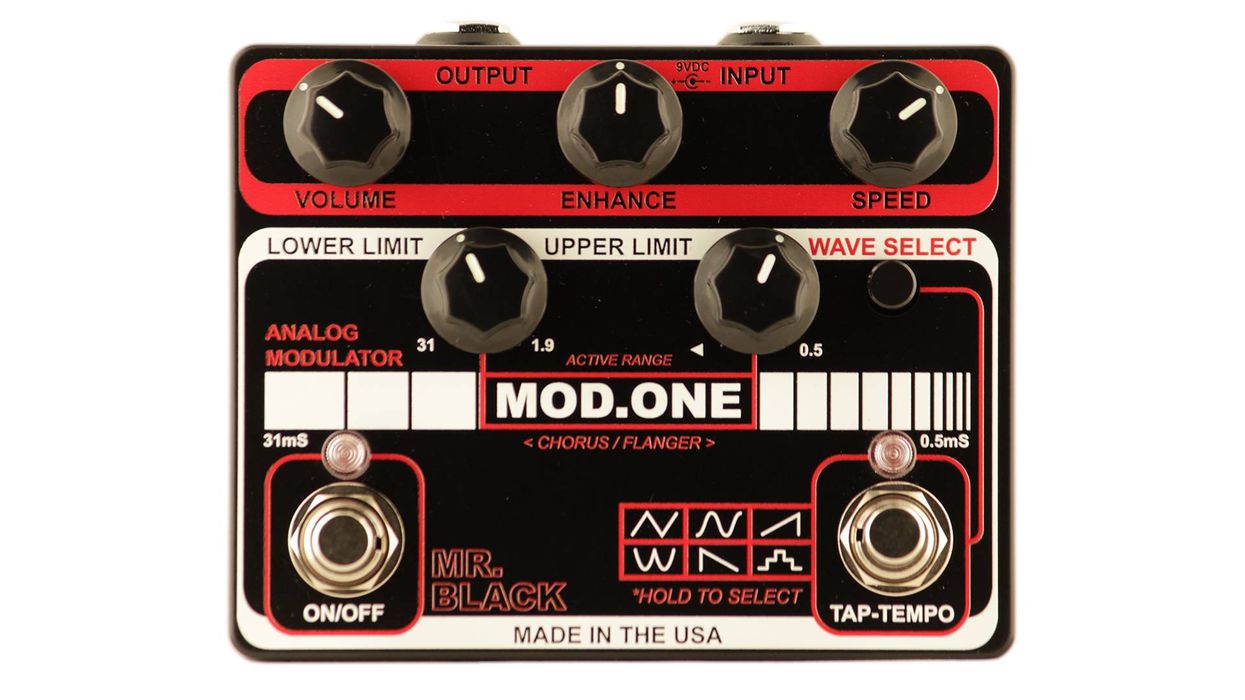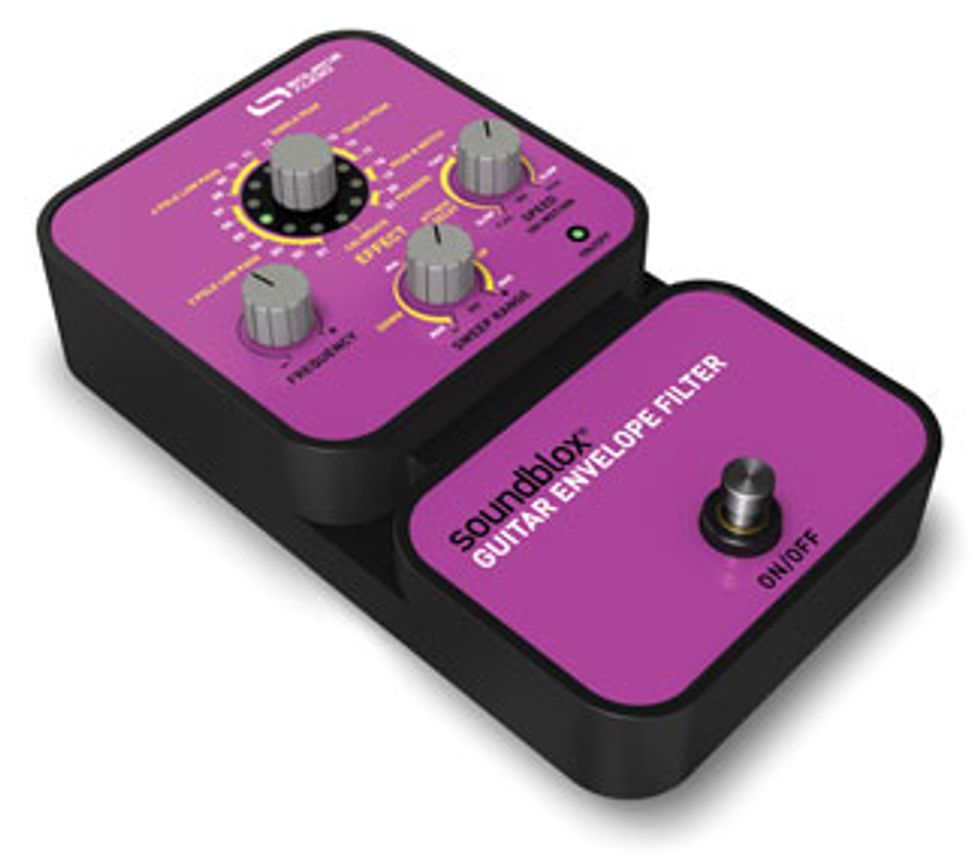
Not far from the same Boston Harbor where the American Revolution was born, there’s a small warehouse complex that houses Source Audio—a band of sonic inventors who’ve embarked on a unique musical mission they feel is also pretty revolutionary. The Woburn, Massachusetts, company sprang onto the effects scene in 2005 with pedals unlike any the world had seen. In contrast to the vintage reimaginings you see from a lot of stompbox makers, they came out with the Hot Hand wah and Hot Hand phaser/flanger—thoroughly modern designs in molded-plastic casings that spoke more to the computer age than the Woodstock era. But looks were only the beginning: These effects enabled a guitarist to control parameters by waving around a ring attached to their finger. But, as it goes for many new kids on the block, Source Audio found that the road forward wasn’t easy.
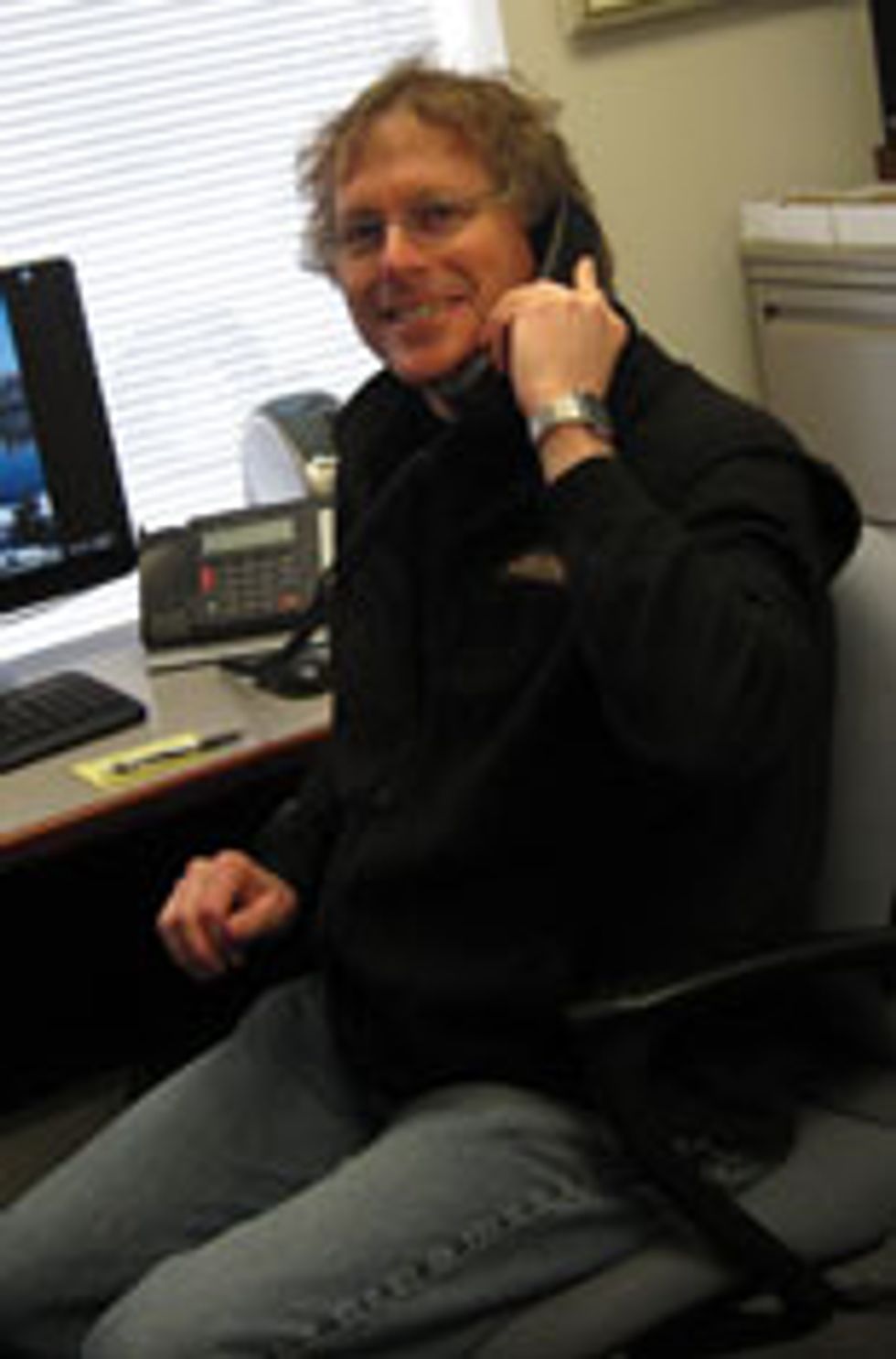
Source Audio president Roger Smith was formerly a “system on chip” designer at Analog Devices, Inc. (ADI).

Jesse Remignanti, Source Audio VP of engineering, works on hardware and user-interface design.
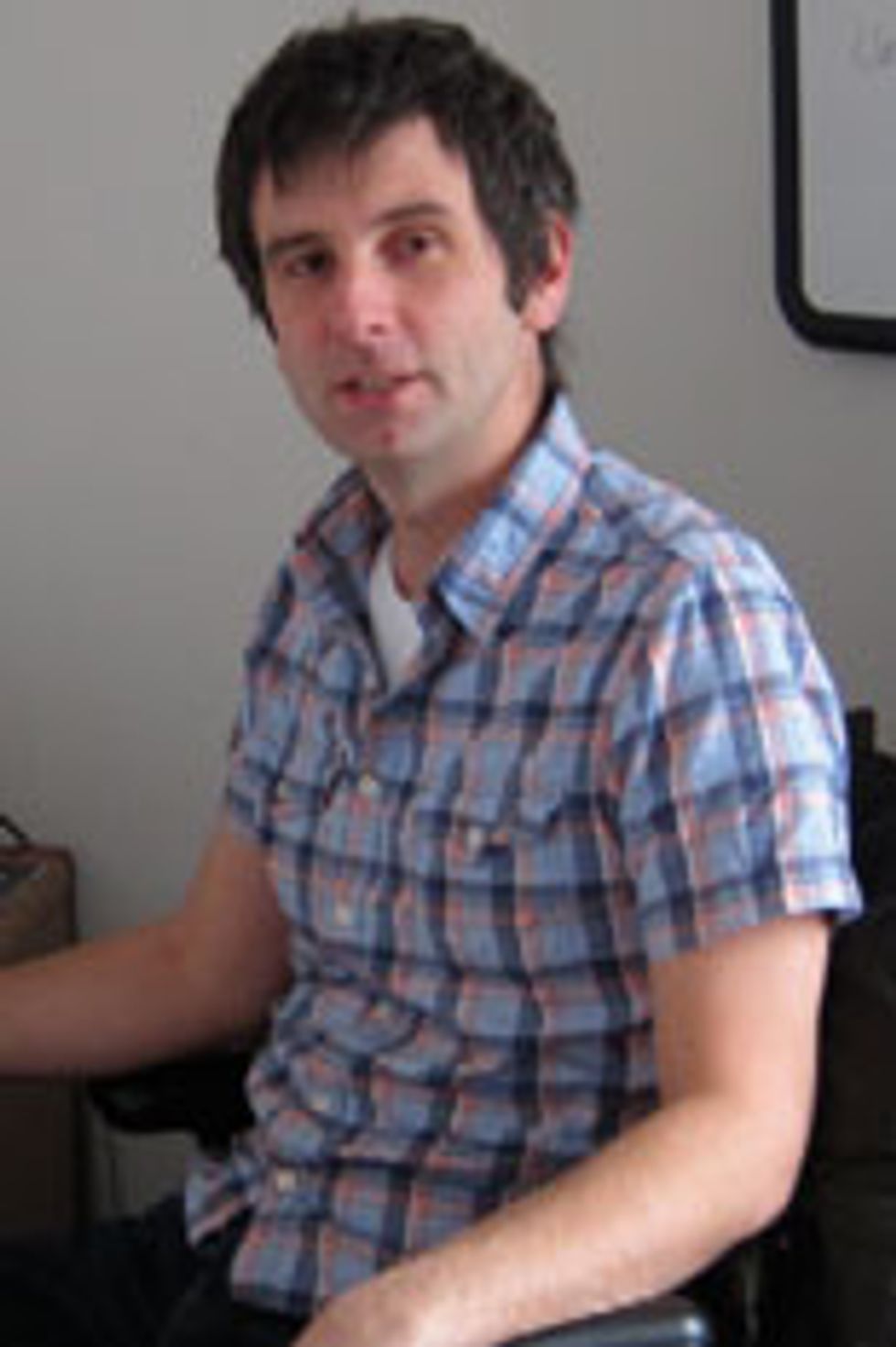
Source Audio videographer Jeff McAlack says guitarists are coming around to digital pedal technology.
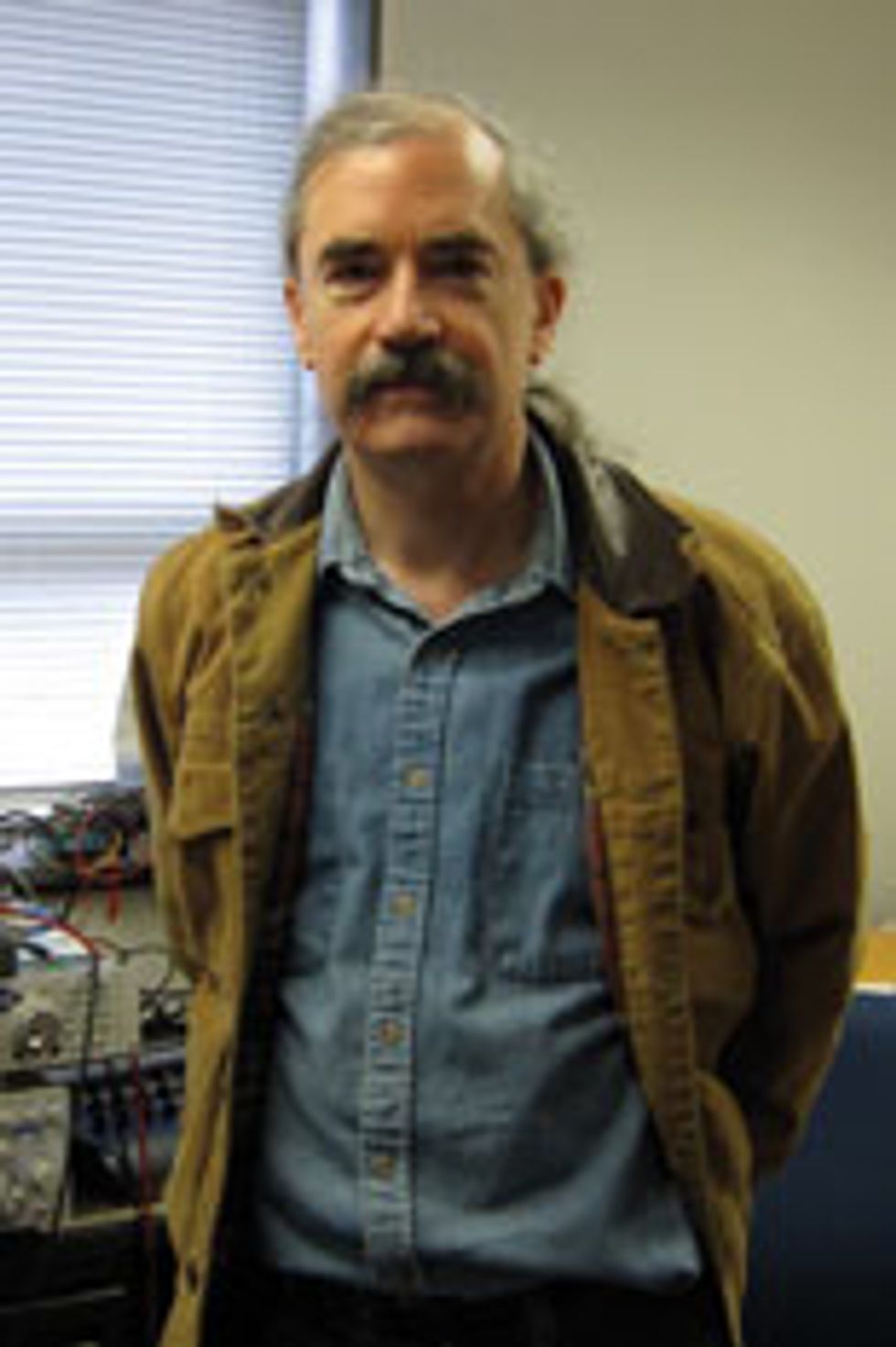
Bob Chidlaw, a former designer at Kurzweil, works with the actual sound elements at Source Audio.
The Human League
It all began at Analog Devices, Inc. (ADI),
a designer and manufacturer of analog
and digital signal processing (DSP) semiconductors
(chips) based in Norwood,
Massachusetts. ADI is one of the world’s
largest producers of mixed signal “system on
chip” designs that have an entire analog and
digital signal path on a single silicon chip.
While working in a chip development group at ADI, future Source Audio president Roger K. Smith met Bob Adams, a legend in the world of analog-to-digital and digital-to-analog converter development. “Bob recognized unique opportunities to put more and more smarts onto the converters,” says Smith. “This is what ultimately formed the chip we use: analog in and analog out, with an enormous amount of processing power in-between.”
ADI’s high-performance SigmaDSP audio processor is at the heart of the SA601 chip used in Source Audio pedals. While some competitive digital devices use 16- or 24-bit audio processing, the SigmaDSP uses a 56-bit processing path, ensuring less digital distortion.
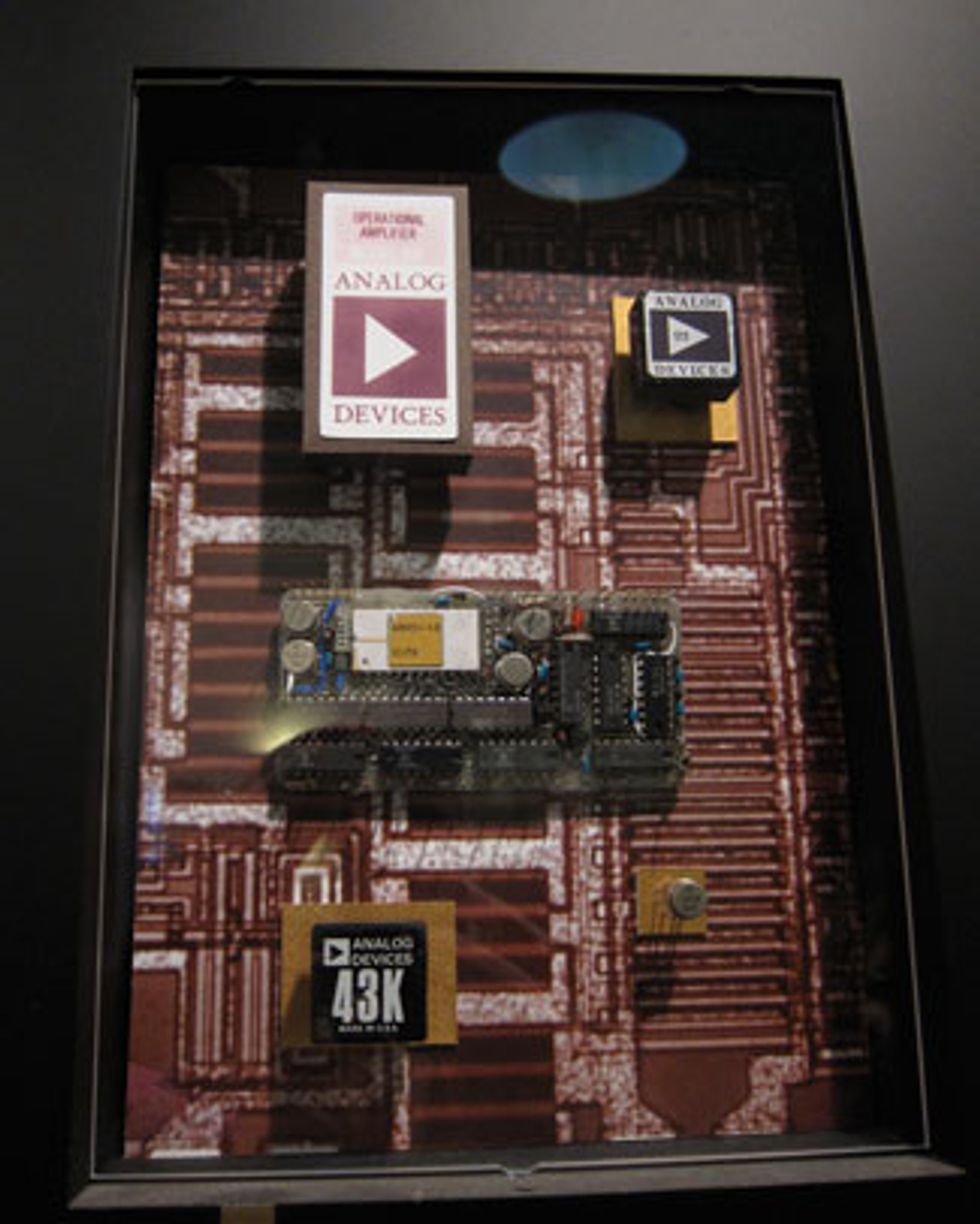
An inside look at “system on chip” technology.
But Source Audio’s story is as much about people as technology: As any guitarist or bassist can attest, it doesn’t matter how fancy the hardware or software is if effects designers don’t know how to make them sound good. While at ADI, Smith met Bob Chidlaw, a former designer at the Kurzweil—a huge name in the keyboard, sampling, and effects market. “Roger and Jesse [Remignanti, Source Audio’s vice president of engineering] were getting itchy to start an effects company and needed a DSP engineer,” says Chidlaw. “I thought it sounded like fun, and it was something I was well suited for.” Chidlaw turned out to be a perfect fit, because his experience playing with guitar, keyboards, and wind instruments gave him a keen sense of how musicians might use the DSP processing in the real world. This technical trio, combined with the business acumen of C. Hunter Boll, became the founding fathers of Source Audio.
Remignanti says it was his interaction with Chidlaw that created the company’s unique take on effects. “I usually come up with the effect idea, then Bob will figure out the algorithms that will make it work. But in some cases he will say, ‘Here’s this algorithm I came up with. How can we make this into a viable product?’ Then I will have to design some sort of interface.” For the most part, Chidlaw works more with the actual sound, while Remignanti works on the hardware and user-interface design. “The best example is the Envelope Filter: Bob will fill it up with as much potential as possible,” says Remignanti. “My job is to simplify the interaction.”
Pedals to Taste
While still at ADI, Remignanti started
working on the software that plays a large
part in Source Audio’s newest concept, the
Flexbox. This pedal depends on the fact
that chips used by Source Audio are manufactured
with the potential to create any
number of different effects, based on the
algorithm supplied to the chip. “At ADI,
we were trying to make it so that people
who didn’t know how to do hardcore coding
for the chips could still use them for
signal processing,” explains Remignanti.
“I started designing Sigma Studio—dragand
drop programming software that lets
me add waveforms and tone modules and
assign them to outputs.”
This software allowed automobile sound-system designers, for example, to tweak the chips in their systems without having to be full-on programmers. “Being a guitar player, I started thinking, ‘What if the waveforms and tone modules were effects instead?,’” he says. “I had experience in hardware and software, so I had the full gamut of skills to do it.” This grabbing of effect algorithms and dropping them into a program along with parameter controls became the Flexbox concept.
Chidlaw writes the algorithm that tells the chip how to affect the input signal. Depending on the code he writes, the end result will be a filter, distortion, or reverb pedal. This flexibility, combined with a layer of the code developed at Analog Devices, is what allows the Flexbox to do more than merely become whatever effect the user desires. “A program running on your PC lets you determine which knob controls which parameter for a specified range from here to there,” explains Chidlaw. “An easy, intuitive display interface for all this stuff gets folded in with my code and downloaded over a USB port to the Flexbox. If you have a basic knowledge of effects, this will allow you to do some unique things on your own—without having a Source Audio engineer standing beside you. We would like to get it to where, in the simplest version, you can just download an effect chosen from a list, with all the knobs preprogrammed for you. If you are dissatisfied with that version because you think, ‘I don’t really use that knob, but there is another thing I would like to control,’ you will be able to reassign some of the controls. Some people won’t want to deal with it, some will, and others will want to go even further.”
The Source Audio MIDI interface (prototype pictured) allows you to run MIDI through the
expression pedal port and daisy-chain it so you can set up scenes with a MIDI controller.
Remignanti elaborates. “Let’s say Bob comes up with an algorithm that could potentially have 20 parameters, but there are only five knobs. In one version of the software, you can download the effect with five preselected parameters, but in another version you will be able to assign your choice of any five parameters out of the 20. You will be able to buy the effect online, tweak it, and download it as a preset into the Flexbox. You can share those presets, but not the effect itself, with your friends.”
The Doors of Perception
Since the company’s inception, the folks
at Source Audio say there have been very
few complaints about the sound their pedals—
though they have had to contend
with a fairly significant prejudice against
pedals that aren’t entirely analog. “There
is that huge wall against digital,” says
Source Audio guitar guru/videographer Jeff
McAlack. “Unlike Line 6 or DigiTech,
we are in a more boutique realm where
it is all about analog—sounding like
Hendrix, or the Stooges, or whoever.”
Again, Remignanti weighs in. “You design it and think it is a cool thing that people will be into—we think of musicians as artists, and artists are usually forward thinking and experimental—but it initially proved to be just the opposite. Guitarists tend to be very conservative and take a long time to come around to an idea like this.”
The company has also struggled with issues once faced by Electro-Harmonix: Some customers have expressed a concern that the units were too big and that the housings didn’t appear to be roadworthy. The first quibble was hard to argue with. Players who wanted to add the original Hot Hands to their pedalboard would have to lose three or four smaller ones to do so. Even the smaller Soundblox series requires a hefty chunk o f real estate. But the second concern about toughness was purely one of semantics. Though the housings are plastic, there is nothing delicate about the type Source Audio uses— they say they’ve literally driven a car over these cases to no ill effects.
Even so, with the Soundblox 2 series, the company has addressed both issues: They now have metal cases that are half the size—and yet they still somehow fit more controls and switches than previous models. “A lot of it is fashion,” says Remignanti, “just changing the knobs to black makes it look more traditional.”
The company has had to accede to the demands of the market in other areas, too. For all its brilliance, the original Hot Hand was tethered to the pedals by wires, restricting hand and arm movement and limiting the ability to control the effect from a distance. So, they quickly moved to make it wireless.
Source Audio pedal prototypes at their headquarters in Woburn, Massachusetts.
A New Fan Bass
While Source Audio is doing its best to
meet the needs and wants of pedal fans,
at the same time the market is evolving to
meet the company’s concept. Even before
Soundblox 2, an unlikely group of allies—
bassists—showed signs of catching up with
the Source Audio vision. Once known
for owning but a single instrument and
plugging straight into the amp, in recent
years bassists have been building pedalboards
that sometimes rival guitarists’. The
company’s pedals started showing up on
more and more of these boards as bassists
became early adopters of the Envelope
Filter, Multiwave Distortion, and Hot
Hand controller.
Berklee College of Music graduate Will Cady—whose multitasking at Source Audio includes bass product line management, marketing, shipping, and customer relations—has some ideas as to why the company’s surge of popularity is being spearheaded by bass players. “First, they are great pedals. Second, we marketed directly to bass players. And third, we got them in front of players a lot of bassists admire,” he explains. “We started with Victor Wooten, then moved on to [Phish’s] Mike Gordon.”
The rise of dubstep also helped. Almost 5 million YouTube views of Nathan Navarro creating wobbling dubstep bass parts using the Hot Hand has sent the remote controllers flying off the shelves. “Nathan is a bass player on the rise,” says Cady. “When his Skrillex cover video went viral, the Hot Hand-controlled Envelope Filter and Wave Distortion became go-to products for a whole new way of playing the bass. We are now tied in with a new genre of music.”
The original circuitry for Source Audio’s Hot Hand Wah Filter.
Through the process of video production, Cady has figured out that you can create the dubstep wobble with just the Multiwave Distortion. “You don’t necessarily need the Envelope Filter pedal,” he explains. “The foldback part of the distortion tends to sound like an envelope filter, so if you set the expression pedal [or Hot Hand] to the distortion mix and set it somewhere in the middle, you can control how it comes in, so it feels like a filter or 8-bit synth.”
Of course, Cady’s own expertise as a bassist helps guide the company’s vision, too. “I play out a lot, so I throw our pedals on my ’board and gig with them,” he says. “I can tell Jesse if an idea is good in theory but might need to be tweaked to be practical in real-world situations. I explained to him that a tap tempo on the LFO of the filter pedal would allow me to play better with a drummer—because I couldn’t quite lock in using the knob. Now the Bass Envelope Filter Pro has a preset switch that can be changed into a tap tempo.”
Guitarists are coming around as well. “Bass players are maybe talking to their guitar players,” posits McAlack. “The Multiwave Distortion is doing better and better. Session guitarist Pete Thorn’s terrific video explained how it is a useful studio tool when you need a melodic line that sounds completely different. Pete had used it on his last record, and he highlighted what’s great about that pedal. The EQ pedal is selling very well, also.”
“One of the reasons players shied away from digital before is that you didn’t have as much control as with analog,” adds Cady. “Now you have the control to get those in-between quirks that you get from analog effects.”
DragonForce’s Herman Li is another big name who’s helped raise the Hot Hand’s profile among guitarists. However, before his and others’ enthusiasm had helped spur a recent surge in sales, orders to the overseas manufacturers of the Hot Hand had temporarily slowed to the point that the factory had destroyed the molds. Since they had to be manufactured again from scratch, Source Audio decided it would be a great time for a redesign.
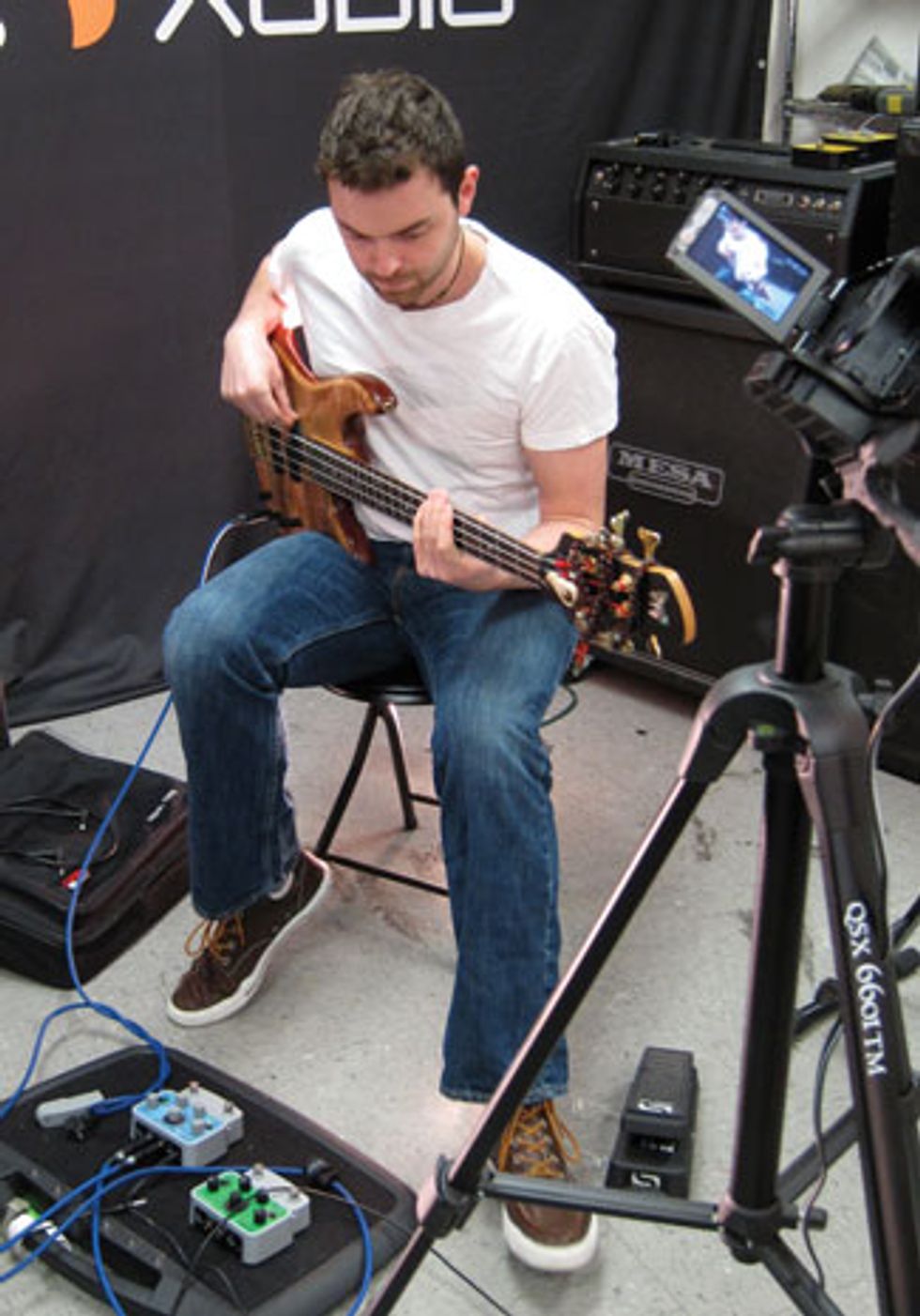
Will Cady is a jack of all trades for Source Audio, handling bass product line management, marketing, shipping, and customer relations.
“The ring will look the same,” says Remignanti, “but we added a third [parameter] axis to give you more options. The biggest difference is the receiver. It will no longer plug into the back of the pedal [the old ones will still work—everything is backward compatible]. It will now be a separate module that connects by cable. It will give you the ability to tweak some parameters right on the module, like depth and filtering— similar to the Source Audio MIDIEXP pedal. It will also have an expression output, so you can use the Hot Hand with third-party pedals.”
For those who want to control effect parameters in real-time in a more traditional manner than the Hot Hand, the original Source Audio pedals and the Soundblox Pro series offer inputs for any standard expression pedal. The Soundblox and Soundblox 2 series work with the company’s own model, which uses a pair of TRS expression outputs to control two effects units simultaneously. Unique to this pedal is a special Sensor Output that connects directly to any Source Audio Hot Hand input, allowing real-time foot control over filter sweeps, effect modulation, LFO speeds, wet/dry mixes, drive levels, etc. “You can use the expression pedal to control many of the parameters, and you can daisy-chain a number of Source Audio pedals so you can use one expression pedal for all of them,” says Remignanti. “With the advent of the Source Audio MIDI interface, you will also be able to run MIDI through the expression pedal port and daisy-chain it so you can set up scenes with a MIDI controller.”
In It for the Long Haul
It has been a long, slow climb for the team
at Source Audio, but a stream of innovative
ideas and quality execution seems to be
leading to a bright future. “Sometimes, [for
a pedal to be accepted] all it takes it one
person doing something really cool with
it,” say Remignanti. “Eventually, you can
win over the more traditional guys, but you
have to be around long enough that they
realize you are not another pedal company
that is here today, gone tomorrow.”
With a new generation of guitarists and bassists who’ve grown up perfectly at home with smartphones, deep recording software, and a broader range of musical tastes than ever before, it’s a safe bet that Source Audio will find a spot on many of their pedalboards and be a company to watch as the future of effects pedals unfolds.

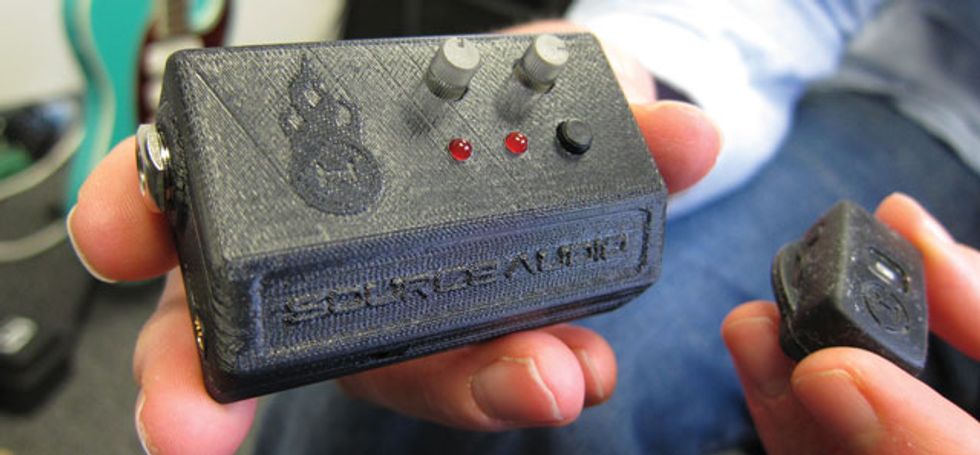
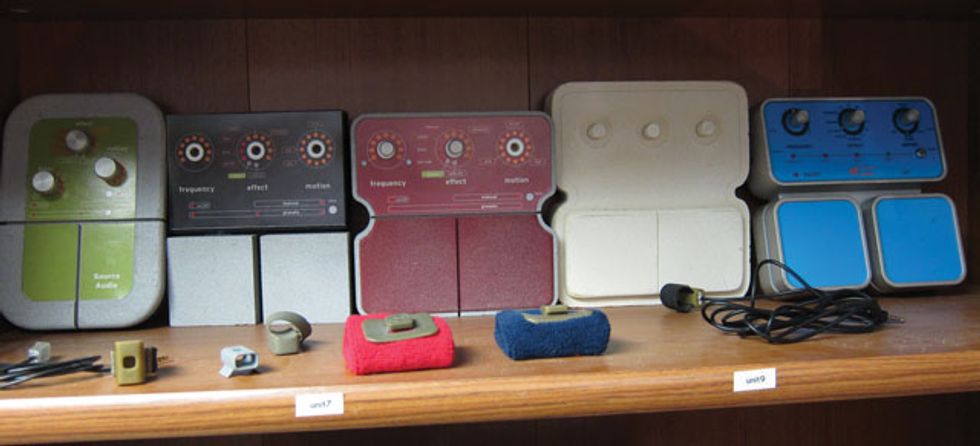





![Rig Rundown: Russian Circles’ Mike Sullivan [2025]](https://www.premierguitar.com/media-library/youtube.jpg?id=62303631&width=1245&height=700&quality=70&coordinates=0%2C0%2C0%2C0)












